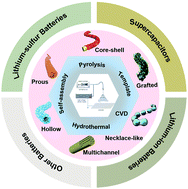Flexible electrodes with high areal capacity based on electrospun fiber mats
Abstract
The ever-growing portable, flexible, and wearable devices impose new requirements from power sources. In contrast to gravitational metrics, areal metrics are more reliable performance indicators of energy storage systems for portable and wearable devices. For energy storage devices with high areal metrics, a high mass loading of the active species is generally required, which imposes formidable challenges on the current electrode fabrication technology. In this regard, integrated electrodes made by electrospinning technology have attracted increasing attention due to their high controllability, excellent mechanical strength, and flexibility. In addition, electrospun electrodes avoid the use of current collectors, conductive additives, and polymer binders, which can essentially increase the content of the active species in the electrodes as well as reduce the unnecessary physically contacted interfaces. In this review, the electrospinning technology for fabricating flexible and high areal capacity electrodes is first highlighted by comparing with the typical methods for this purpose. Then, the principles of electrospinning technology and the recent progress of electrospun electrodes with high areal capacity and flexibility are elaborately discussed. Finally, we address the future perspectives for the construction of high areal capacity electrodes using electrospinning technology to meet the increasing demands of flexible energy storage systems.

- This article is part of the themed collection: Recent Review Articles


 Please wait while we load your content...
Please wait while we load your content...